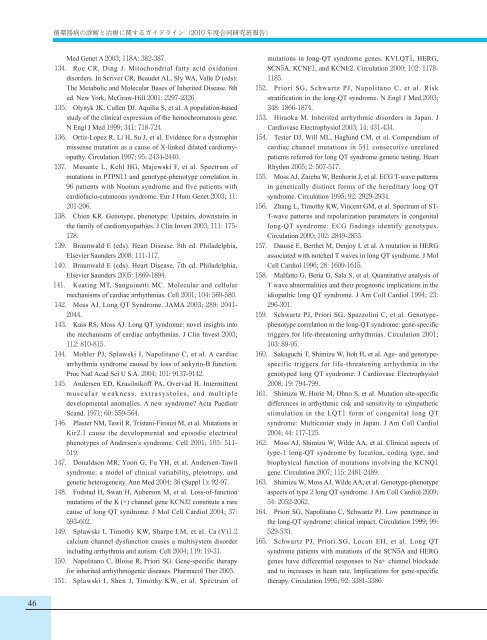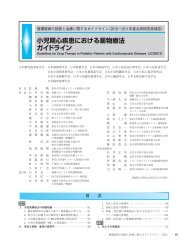å¿èè¡ç®¡ç¾æ£ã«ãããéºä¼å¦çæ¤æ»ã¨éºä¼ã«ã¦ ... - æ¥æ¬å¾ªç°å¨å¦ä¼
å¿èè¡ç®¡ç¾æ£ã«ãããéºä¼å¦çæ¤æ»ã¨éºä¼ã«ã¦ ... - æ¥æ¬å¾ªç°å¨å¦ä¼
å¿èè¡ç®¡ç¾æ£ã«ãããéºä¼å¦çæ¤æ»ã¨éºä¼ã«ã¦ ... - æ¥æ¬å¾ªç°å¨å¦ä¼
You also want an ePaper? Increase the reach of your titles
YUMPU automatically turns print PDFs into web optimized ePapers that Google loves.
循 環 器 病 の 診 断 と 治 療 に 関 するガイドライン(2010 年 度 合 同 研 究 班 報 告 )Med Genet A 2003; 118A: 382-387.134. Roe CR, Ding J. Mitochondrial fatty acid oxidationdisorders. In Scriver CR, Beaudet AL, Sly WA, Valle D (eds):The Metabolic and Molecular Bases of Inherited Disease. 8thed. New York, McGraw-Hill 2001: 2297-2326.135. Olynyk JK, Cullen DJ, Aquilia S, et al. A population-basedstudy of the clinical expression of the hemochromatosis gene.N Engl J Med 1999; 341: 718-724.136. Ortiz-Lopez R, Li H, Su J, et al. Evidence for a dystrophinmissense mutation as a cause of X-linked dilated cardiomyopathy.Circulation 1997; 95: 2434-2440.137. Musante L, Kehl HG, Majewski F, et al. Spectrum ofmutations in PTPN11 and genotype-phenotype correlation in96 patients with Noonan syndrome and five patients withcardiofacio-cutaneous syndrome. Eur J Hum Genet 2003; 11:201-206.138. Chien KR. Genotype, phenotype: Upstairs, downstairs inthe family of cardiomyopathies. J Clin Invest 2003; 111: 175-178.139. Braunwald E (eds). Heart Disease. 8th ed. Philadelphia,Elsevier Saunders 2008: 111-117.140. Braunwald E (eds). Heart Disease. 7th ed. Philadelphia,Elsevier Saunders 2005: 1869-1894.141. Keating MT, Sanguinetti MC. Molecular and cellularmechanisms of cardiac arrhythmias. Cell 2001; 104: 569-580.142. Moss AJ. Long QT Syndrome. JAMA 2003; 289: 2041-2044.143. Kass RS, Moss AJ. Long QT syndrome: novel insights intothe mechanisms of cardiac arrhythmias. J Clin Invest 2003;112: 810-815.144. Mohler PJ, Splawski I, Napolitano C, et al. A cardiacarrhythmia syndrome caused by loss of ankyrin-B function.Proc Natl Acad Sci U S A. 2004; 101: 9137-9142.145. Andersen ED, Krasilnikoff PA, Overvad H. Intermittentmuscular weakness, extrasystoles, and multipledevelopmental anomalies. A new syndrome? Acta PaediatrScand. 1971; 60: 559-564.146. Plaster NM, Tawil R, Tristani-Firouzi M, et al. Mutations inKir2.1 cause the developmental and episodic electricalphenotypes of Andersen’s syndrome. Cell 2001; 105: 511-519.147. Donaldson MR, Yoon G, Fu YH, et al. Andersen-Tawilsyndrome: a model of clinical variability, pleiotropy, andgenetic heterogeneity. Ann Med 2004; 36 (Suppl 1): 92-97.148. Fodstad H, Swan H, Auberson M, et al. Loss-of-functionmutations of the K (+) channel gene KCNJ2 constitute a rarecause of long QT syndrome. J Mol Cell Cardiol 2004; 37:593-602.149. Splawski I, Timothy KW, Sharpe LM, et al. Ca (V)1.2calcium channel dysfunction causes a multisystem disorderincluding arrhythmia and autism. Cell 2004; 119: 19-31.150. Napolitano C, Bloise R, Priori SG. Gene-specific therapyfor inherited arrhythmogenic diseases. Pharmacol Ther 2005.151. Splawski I, Shen J, Timothy KW, et al. Spectrum ofmutations in long-QT syndrome genes. KVLQT1, HERG,SCN5A, KCNE1, and KCNE2. Circulation 2000; 102: 1178-1185.152. Priori SG, Schwartz PJ, Napolitano C, et al. Riskstratification in the long-QT syndrome. N Engl J Med.2003;348: 1866-1874.153. Hiraoka M. Inherited arrhythmic disorders in Japan. JCardiovasc Electrophysiol 2003; 14: 431-434.154. Tester DJ, Will ML, Haglund CM, et al. Compendium ofcardiac channel mutations in 541 consecutive unrelatedpatients referred for long QT syndrome genetic testing. HeartRhythm 2005; 2: 507-517.155. Moss AJ, Zareba W, Benhorin J, et al. ECG T-wave patternsin genetically distinct forms of the hereditary long QTsyndrome. Circulation 1995; 92: 2929-2934.156. Zhang L, Timothy KW, Vincent GM, et al. Spectrum of ST-T-wave patterns and repolarization parameters in congenitallong-QT syndrome: ECG findings identify genotypes.Circulation 2000; 102: 2849-2855.157. Dausse E, Berthet M, Denjoy I, et al. A mutation in HERGassociated with notched T waves in long QT syndrome. J MolCell Cardiol 1996; 28: 1609-1615.158. Malfatto G, Beria G, Sala S, et al. Quantitative analysis ofT wave abnormalities and their prognostic implications in theidiopathic long QT syndrome. J Am Coll Cardiol 1994; 23:296-301.159. Schwartz PJ, Priori SG, Spazzolini C, et al. Genotypephenotypecorrelation in the long-QT syndrome: gene-specifictriggers for life-threatening arrhythmias. Circulation 2001;103: 89-95.160. Sakaguchi T, Shimizu W, Itoh H, et al. Age- and genotypespecifictriggers for life-threatening arrhythmia in thegenotyped long QT syndrome. J Cardiovasc Electrophysiol2008; 19: 794-799.161. Shimizu W, Horie M, Ohno S, et al. Mutation site-specificdifferences in arrhythmic risk and sensitivity to sympatheticstimulation in the LQT1 form of congenital long QTsyndrome: Multicenter study in Japan. J Am Coll Cardiol2004; 44: 117-125.162. Moss AJ, Shimizu W, Wilde AA, et al. Clinical aspects oftype-1 long-QT syndrome by location, coding type, andbiophysical function of mutations involving the KCNQ1gene. Circulation 2007; 115: 2481-2489.163. Shimizu W, Moss AJ, Wilde AA, et al. Genotype-phenotypeaspects of type 2 long QT syndrome. J Am Coll Cardiol 2009;54: 2052-2062.164. Priori SG, Napolitano C, Schwartz PJ. Low penetrance inthe long-QT syndrome: clinical impact. Circulation 1999; 99:529-533.165. Schwartz PJ, Priori SG, Locati EH, et al. Long QTsyndrome patients with mutations of the SCN5A and HERGgenes have differential responses to Na+ channel blockadeand to increases in heart rate. Implications for gene-specifictherapy. Circulation 1995; 92: 3381-3386.46




